Illustrator John Falter was originally a country boy, but he couldn’t get enough of New York City’s stately buildings and elegant parks. These covers show Falter’s affection for New York.
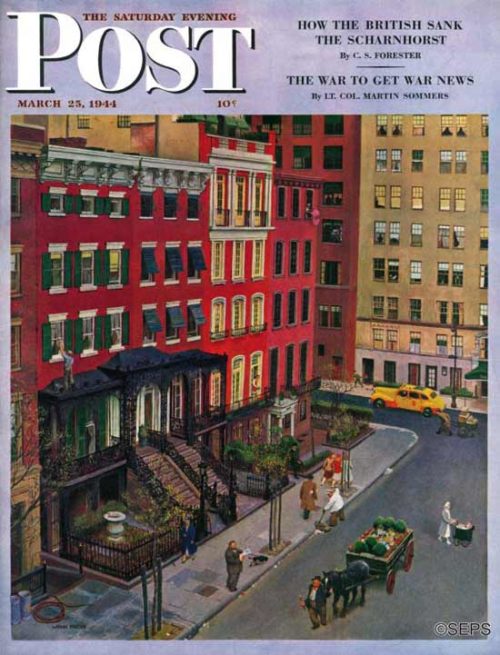
March 25, 1944
John Falter was born in Plattsmouth, Nebraska, although his family homestead was in Atchison, Kansas. He started his illustration career by selling his first artwork in 1930 to Liberty, a pulp magazine. The Liberty commission gave him the exposure he needed to gain other clients, including Gulf Oil Company, Four Roses Whiskey, Arrow Shirts, and, of course, the Saturday Evening Post, for whom he painted 129 covers. His first cover for the Post was a portrait of Ben Franklin. This painting of Gramercy Park appeared about a year later, and was followed by many more covers of New York scenes.
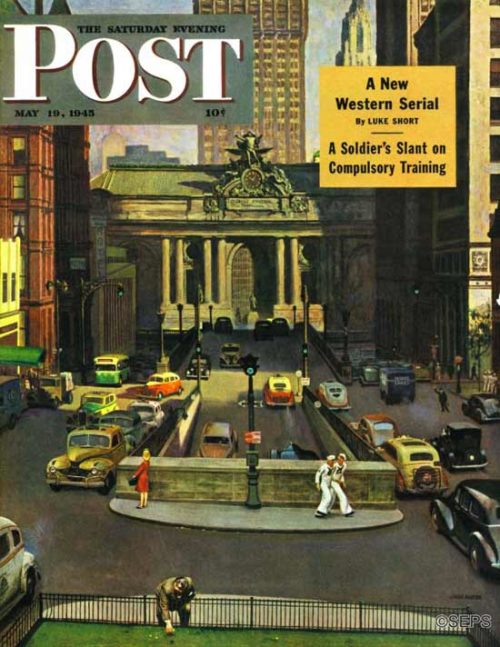
May 19, 1945
[From the editors of the May 19, 1945 issue] Pershing Square, John Falter’s cover on this week’s Post, is a view of Park Avenue, New York, looking toward the Grand Central Terminal, through which more than 62,000,000 passengers have passed in a single year. On the left is the old Murray Hill Hotel, opened in 1884 and one of Manhattan’s more elderly landmarks. Across the street on the right is a group of servicemen lined up waiting to get into the Recreation Center, to get tickets to theaters, concerts, movies and radio broadcasts which are given without charge. In the same building, New York teachers operate a canteen for enlisted men and women. Food cooked at the Food Trades High School is served free. Teachers spend their spare time here and teach the service personnel any subject they wish to learn.
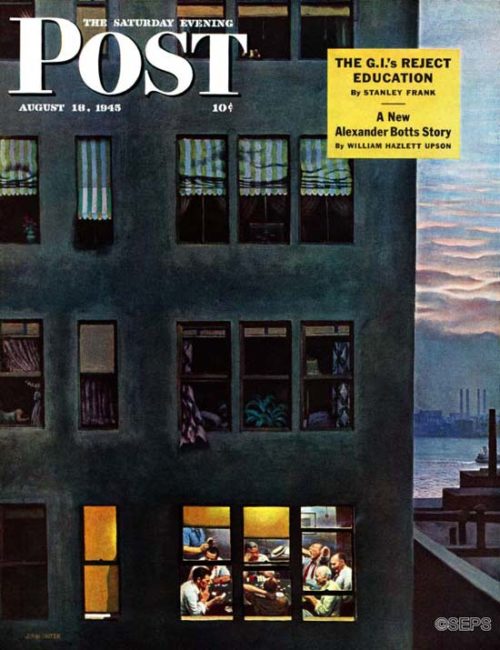
August 18, 1945
[From the editors of the August 18, 1945 issue] Not long ago a contributor’s effort to replace his gaming losses brought us a story that otherwise wouldn’t have been written. But this week’s cover is the first time getting out from behind a poker eight-ball has paid off in art work for us. One night recently John Falter became embroiled in a “little game” at The Players, during the course of which he discovered that drawing to an inside straight was much less rewarding than drawing for Post Art Editor Ken Stuart. The game was dealer’s choice, so when Falter’s turn came he decreed a round of Artists and Models and transported the game to his studio. There Falter poker player gave way to Falter artist, and he settled down to making sketches of his friends working their way through stacks of blues and reds. That’s Falter with his back to the window. It’s the first time he’s ever put himself in a painting—with or without a pat hand.
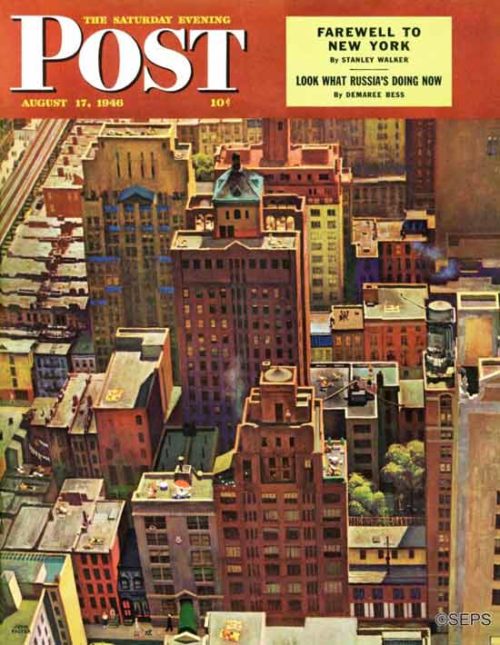
August 17, 1946
[From the editors of the August 17, 1946 issue] The enthusiasm for sun bathing is so general, these days, that the roofs of any major American city would have provided a scene such as John Falter painted for this week’s cover. He chose New York. The view is from the fifty-fourth floor of the Chrysler Building, looking south. There were sun bathers on almost every roof, stewing, frying and boiling in the early afternoon sun, some in quest of health, and more, perhaps, in quest of an expensive-looking sun tan. A good many office workers at that altitude stand prepared, in case anything really beautiful comes into view, to look more closely. They keep telescopes handy.
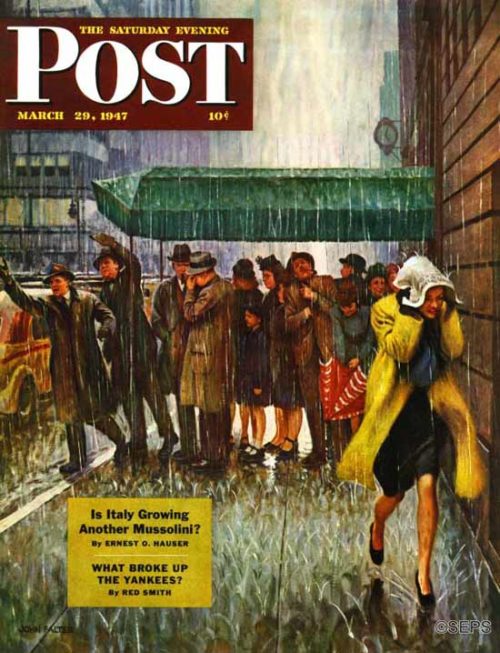
March 29, 1947
[From the editors of the March 29, 1947 issue] It is more than a spring downpour that John Falter records in this big city scene; it is a phenomenon the weather experts keep still about, probably because they can’t explain it, one of Nature’s little practical jokes. The day will be beautiful from the time thousands of men and women settle down for the day’s work until 4:55 in the afternoon; the sky smiling, not a cloud anywhere except a couple as innocent as cotton batting. But exactly at quitting time, at the moment best calculated to catch thousands between office and home, down comes the rain, like a sack of water thrown from a hotel window or a pan rigged over the door on April Fool’s Day. It quits just as punctually, when you reach home.
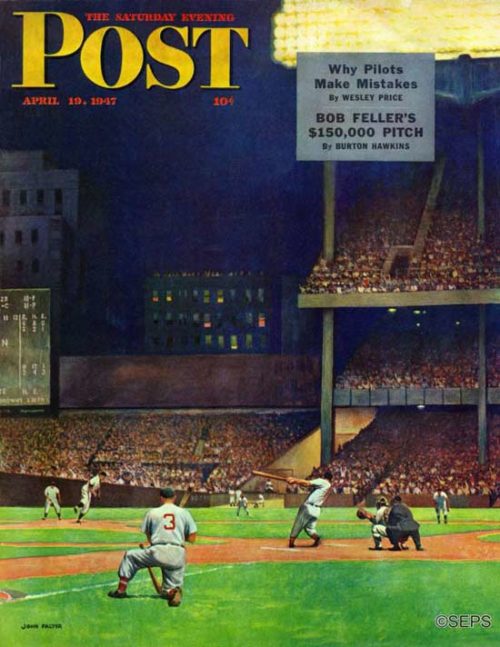
April 19, 1947
[From the editors of the April 19, 1947 issue] And you’re out, as out as the mighty Casey himself. Even without the razor-blade-advertising signs, many baseball fans will know that John Falter made his cover sketches in Yankee Stadium, a pleasant research chore that forced him to see three or four very good ball games. Instead of the winning hit or a homer, Falter selected a big moment of another kind. His subject is the satisfying moment when the visitors are at bat in a tight game, the gent with the club has two strikes on him, the home-town pitcher comes through with a beauty, the batter swings and misses. The Boston Red Sox were in town when Falter did his sketching last July, and they were on their way to the pennant.
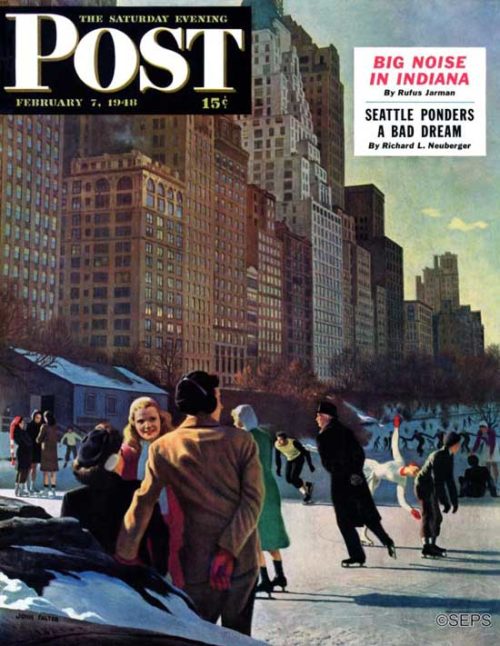
February 7, 1948
[From the editors of the February 7, 1948 issue] The scene of John Falter’s painting is Central Park, New York. Falter is a country boy, and it has always seemed strange to him that there should be skating just across the way from big-city buildings. He has also been puzzled by the variety of skating costumes he sees on the ice in Central Park—ranging from the most colorful of outdoor clothing to the most sedate business outfit. The gent in the dark overcoat, for example, must have put his skates on during a meeting of the board of directors. “But the real reason I painted the cover,” Falter said,”was to see if I could paint that many windows. I figure that if everyone who lives behind all those windows would buy a copy of the Post, the issue would be a sellout.”
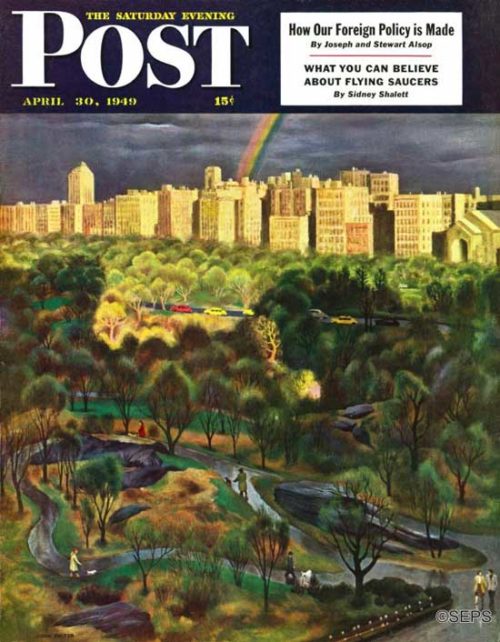
April 30, 1949
[From the editors of the April 30, 1949 issue] When John Falter’s cover painting was accepted, there was lightning trickling down the sky beside the rainbow. Presently the Art Department began to worry—do lightning and rainbows ever show up at the same time? The ever helpful Weather Bureau was asked to look at the Post‘s storm—which has just doused midtown New York and is rumbling away beyond Central Park’s man-made ramparts. “Fair and cooler,” was the comment. “But we never saw a streak of lightning in such bright daylight. Of course, where weather is concerned, anything can happen.” So the picture was delightninged, leaving only that sign of clearing weather, a patch of blue sky large enough to make a sailor a pair of breeches.
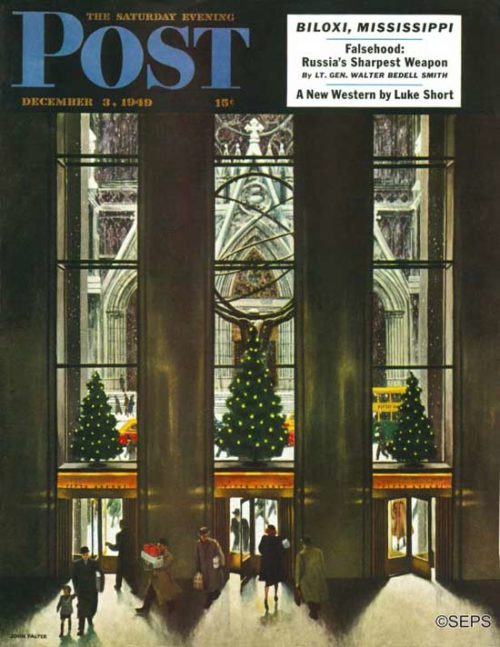
December 3, 1949
[From the editors of the December 3, 1949 issue] John Falter chose a Christmas shopping scene which New Yorkers could enjoy to the full, but are apt to miss while endeavoring not to fall downstairs. As you look at the Gothic architecture of St. Patrick’s Cathedral framed in the contrasting modern character of Rockefeller Center’s principal Fifth Avenue building, you are standing in imagination on the edge of the mezzanine floor. But you’d better watch your step or you’ll go down faster than the moving stairs do. The Christmas trees are by courtesy of Falter, who had to sweat while erecting them on his canvas, because he did the painting in steamy weather last summer. And did that whee him up to do his Christmas shopping early? The last we heard. he hadn’t bought a thing.
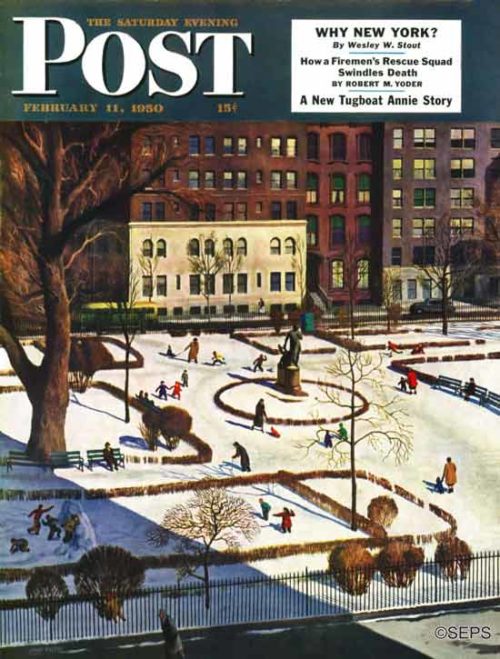
February 11, 1950
[From the editors of the February 11, 1950 issue] When John Falter runs up to New York from the open spaces of Pennsylvania’s Bucks County, he usually runs right downtown to The Players club, from where, as his painting shows, he can regard the open spaces of Gramercy Park. In the park you see the statue of Edwin Booth, the club’s founder, contemplating the citified version of a winter sports scene. Poet Percy Mackaye, a familiar figure around The Players, remembers that his great-grandfather loved to sit under the ancient tree at the left. Falter once had a studio in a building next to The Players; he says he has made his view of the park from a point about where the two buildings join, and between the third and fourth floors. Quite a stunt without a helicopter.
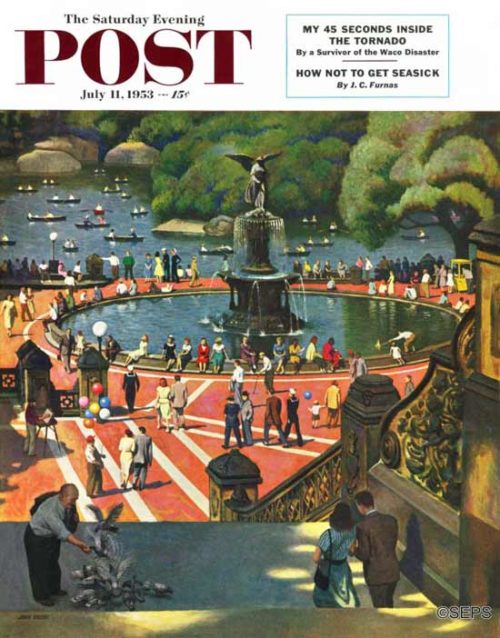
John Falter
July 11, 1953
[From the editors of the July 11, 1953 issue] In New York’s famous wilderness, Central Park, you can hike, boat, bicycle, ride horseback, woo a wife, climb small mountains, get lost in small woods, and on the zoo trail meet many wild animals including people who make faces at monkeys. If you don’t think New Yorkers get more exercise than country people, buy some liniment and see how far you can trudge in the park without crying, “Help! Taxi!” To this resort go many sailors to take a vacation from water by rowing a boat weighted down by a girl—a curious phenomenon, as you would think the girl would row the sailor. That one soldier in the picture is not lost; he is following the girl. And that painter is not John Falter—John can paint without a beard.
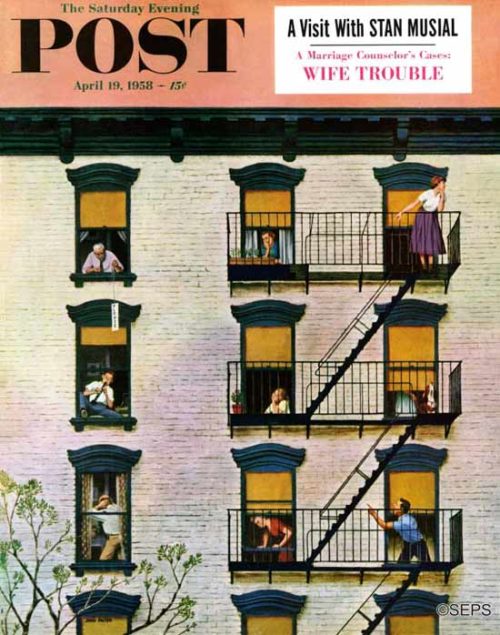
April 19, 1958
[From the editors of the April 19, 1958 issue] The day’s toil is over; the quiet magic of approaching dusk offers peace to everyone; and from the heart and clarinet of a grateful soul come the limpid strains of an evensong. They come not from afar, but from anear, and all who hear them are stirred—some in favor, some against. Numerically, the nays have it. including that man who votes Please, which doesn’t mean Please Play Louder, but Please Dry Up. The howling dog may think he is singing a tuneful duet with the clarinet or he may just be swearing at it; let’s say he votes yes, for artist John Falter is pro-clarinet (he plays one). Another way to count those votes is the way of the heart: only two people are on that cover, a boy and a girl, and to them everybody else is nowhere at all. The two are unanimous.
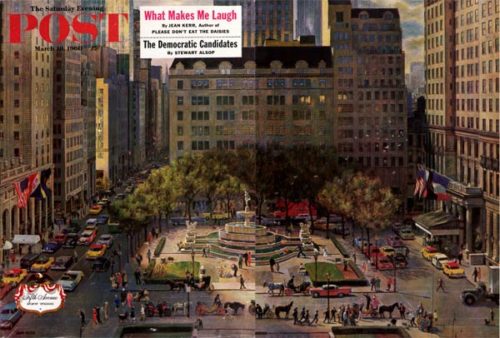
March 19, 1960
[From the editors of the March 19, 1960 issue] Fifth Avenue—showcase of fashion, hub of big industry, parade ground for visiting celebrities, home to the very rich. In her 135 blocks between Greenwich Village and Harlem are such landmarks as the Empire State Building, Rockefeller Center, St. Patrick’s Cathedral and the Metropolitan Museum of Art—but nowhere is she quite so magnificent and vivacious as here at Fifty-ninth Street, gateway to Central Park. Between the sun-splashed windows of Tiffany’s (left center) and the forlorn figure of Eloise, gazing down from her perch at the Plaza (right), artist John Falter has captured a brilliant Saturday morning in April. (After studying our scene long enough to spot the pickpocket, turn to page 126.)
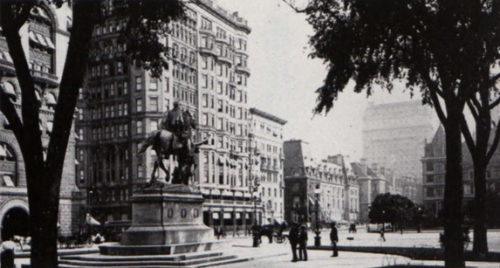
[p. 126] With this week’s gatefold-cover painting, we inaugurate a series of covers—to appear from time to time—on some of America’s more illustrious streets. Some of those under consideration: Atlanta’s Peachtree Street, Chicago’s Michigan Avenue, New Orleans’ Bourbon Street, Kansas City’s Petticoat Lane. The Fifth Avenue scene chosen by artist John Falter seemed an appropriate introduction to the series, for in this delightful panorama we can observe the beauty and vitality of today and much of the charm of the past. Only a century ago this same area was a muddy crossroads, and its most notable landmark was the ice pond and clubhouse of the New York Skating Club, on what is now the site of the Plaza Hotel. By 1904, when the photograph at left was taken, the brownstone mansion was in its glory. The Netherland and Savoy hotels (left) were only a dozen years old, and the towering St. Regis, four blocks south, was brand new. No one dreamed that Cornelius Vanderbilt’s French Renaissance château (right) would be demolished to make room for Bergdorf Goodman, the marble emporium at the center of our cover. The graceful Pulitzer Fountain seen on our cover had not yet been built, but General Sherman was already astride his bronze charger. Today the picturesque victoria carriages which line the curb along Central Park South are perhaps the most romantic link with the Fifth Avenue of the early 1900’s. Most of the stately brownstones are gone, but in their place have come equally sumptuous structures of steel and glass. “The face of the avenue has changed beyond belief,” one chronicler has written, “but its character has remained constant.”
Become a Saturday Evening Post member and enjoy unlimited access. Subscribe now
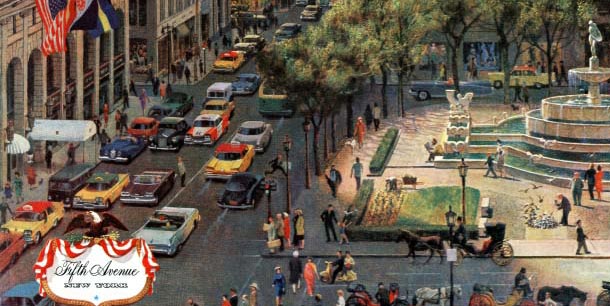


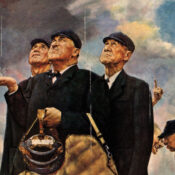
Comments
All of these beautiful covers each give a unique look at mid-century New York from different angles at different times of the year. Often they’re a view from above where the detailed scenery is more important than the people.
Thank you for including the POST editors comments for each given issue here. It helped me appreciate each one all the more. The gatefold-cover was spectacular. A comparable painting of the exact same scene 57 years later would be fascinating to see, but I doubt nearly as beautiful.